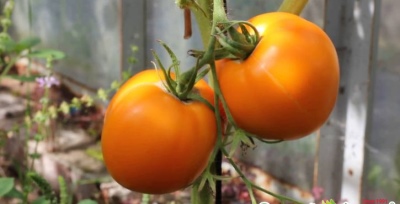
- Authors: Dederko V.N., Postnikova O.V.
- Year of approval: 2007
- Name synonyms: Collegiate Meal
- Category: grade
- Growth type: determinant
- Appointment: universal
- Ripening period: mid-season
- Ripening time, days: 125-130
- Growing conditions: for open ground
- Transportability: high
Many gardeners choose this or that culture based on its taste. Separately, there are varieties that can be used as a dietary product. Tomato Monastic meal belongs to just such.
Breeding history
This variety was bred by breeders Dederko V.N. and Postnikova O.V. The plant was approved for use in 2007. Also found under the name Collegiate Meal. It belongs to the universal type and is grown in many regions of Russia.
Description of the variety
Tomato A monastic meal belongs to determinant crops and has limited vigor. In the garden bed, the height of the plant reaches 70-100 cm, and in the greenhouse - 150 cm. The stem is powerful, well-developed. The root system grows shallowly, while the bush is kept firmly in the ground. The crown is semi-spreading. It is necessary to tie the bush to the support.
The leaves are medium, slightly oblong, dark green in color, similar to potato tops. The leaf plate has: a mid-section, veins, small notches along the edging and pubescence. Due to severe drought or, conversely, from waterlogging, the leaves can curl up into a tube or bend. If the leaves are sunburned, they will begin to turn yellow and dry.
The first ovary ripens next to the 6th leaf. Subsequent - in one. The inflorescence is of a simple type. 7-9 racemes are formed on the main stem. 2-5 fruits ripen on one bunch. The recommended number of stems is 1-2.
The advantages include:
appearance;
yield;
taste qualities;
universal application;
the determinancy of the variety;
fruits are suitable for dietary nutrition.
The disadvantages are:
the need for pinching and forming a bush;
the possibility of fruit cracking;
tying to a support.
The main qualities of the fruit
Large, rounded fruits. On the brush, tomatoes of the same size ripen, identical to each other. The color of the peel in mature fruits is orange or bright orange, in unripe fruits it is light green. The average weight of one vegetable is 167 g. On the lower branches, even larger ones, up to 200 g, can ripen. This usually happens at the beginning of the season.
The skin is dense, glossy, with a slight sheen, the stalk has a ribbing, but it is not pronounced and is not found in all tomatoes. Excess moisture can cause the peel to crack.
The pulp is tender, dense, slightly watery. Inside, many small chambers with a small number of seeds are formed.
Culture is universal. The fruits can be eaten fresh, used for salads, sauces, juices, lecho, as well as for canning and pickling.
Tomato Monastic meal due to the lack of red pigment is suitable for people with allergies. The vegetable can be added to the diet of people on a diet.
Taste characteristics
Many people note good taste and almost complete absence of sour aftertaste.
Ripening and fruiting
Tomato Monastic meal is a mid-season crop, ripens within 125-130 days. Fruiting is extended and may increase in bad weather. On average, harvesting begins in late June and lasts until mid-August.
Yield
Good yields depend on weather conditions and agricultural practices. On average, 5.1 kg of tomatoes are removed from 1 m2.
The timing of planting seedlings and planting in the ground
For sowing, it is necessary to prepare seedling boxes and soil.The seeds are soaked in water, then treated with potassium permanganate. In the boxes, holes are made 2 cm deep. After planting the seeds, everything is spilled with warm water, covered with a film. The boxes must be removed to the windowsill. The temperature should be around +22 degrees. After 7 days, when the seeds hatch, the film is removed.
Young bushes should be irrigated with a spray bottle, top dressing should be applied in liquid form.
The pick is done twice. The first time, when the stems form a few strong leaves. The second is when the plant has already been planted in a permanent place. 50-60 days should pass between sowing seeds and transplanting into the ground.

Growing tomato seedlings is an extremely important process, because it largely depends on whether the gardener will be able to harvest at all. All aspects must be taken into account, from seedbed preparation to planting in the ground.
Landing scheme
The hole is made 15 cm deep. It is better to plant seedlings in a checkerboard pattern according to the scheme of 3-4 plants per 1 m2. This will provide even air circulation between the bushes, making it easier to handle plants and harvest.

Growing and care
For a good harvest, several points must be observed.
After planting seedlings in the ground, they are not touched for a week in order for them to take root.
Watering from once a week. Increased irrigation will depend on drought.
Loosening of the soil is done after watering. The topsoil is broken up to provide oxygen to the roots.
For feeding, minerals with a content of nitrogen, potassium, phosphorus are selected. From natural fertilizers, wood ash, manure and bird droppings are chosen.
It is necessary to timely carry out the garter to the pegs and the formation of the stem.




A plant needs different micronutrients at each stage of growth. All fertilizers can be divided into two groups: mineral and organic. Folk remedies are often used: iodine, yeast, bird droppings, eggshells.
It is important to observe the rate and period of feeding. This also applies to folk remedies and organic fertilizers.



























































































